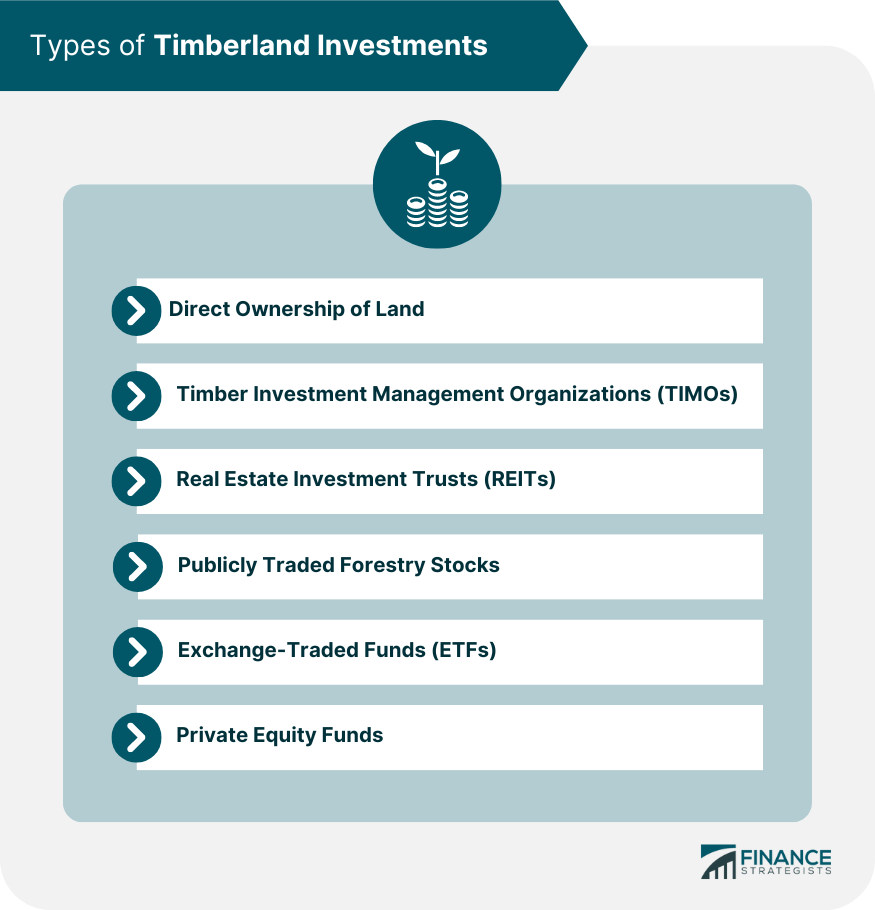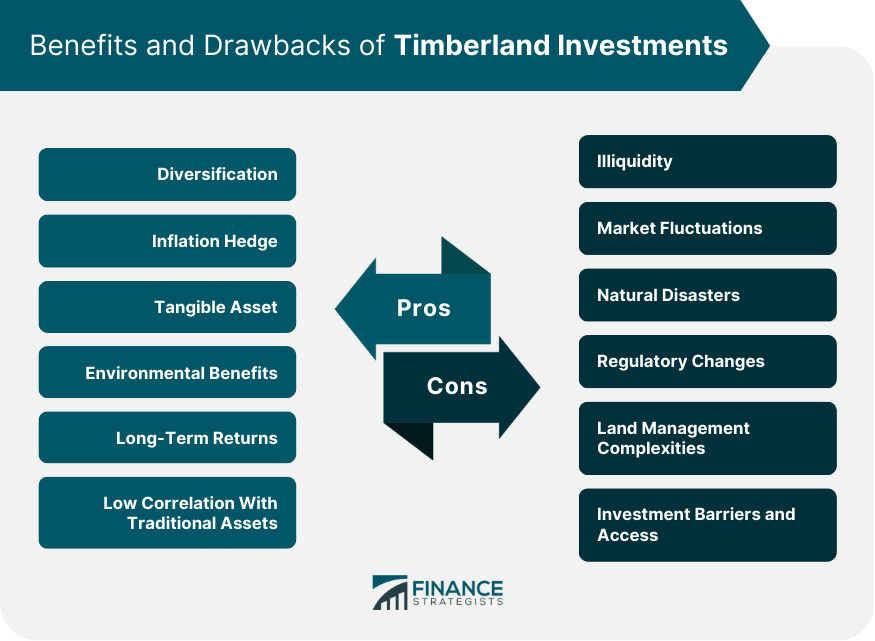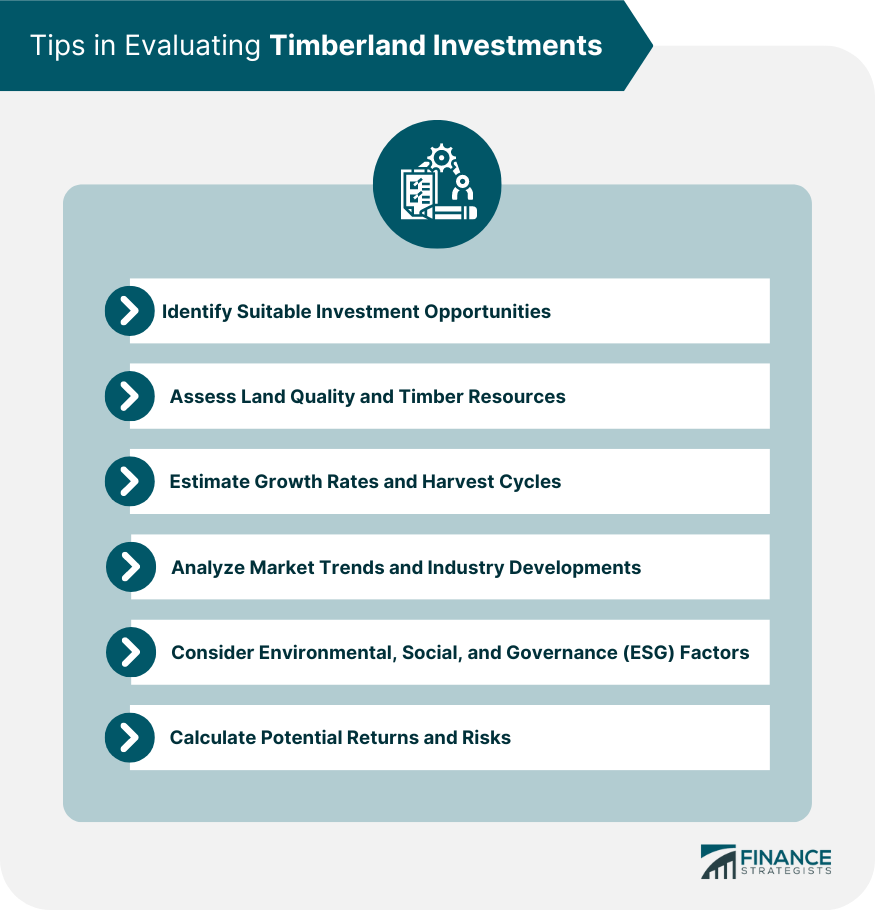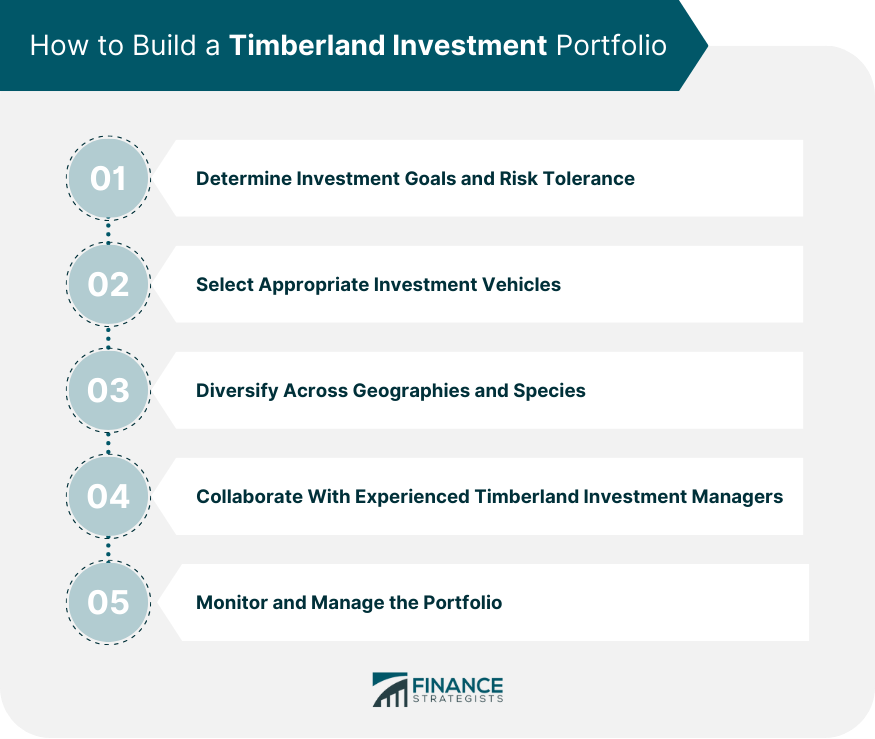Timberland investments refer to the acquisition and management of land with forests for the purpose of producing income and long-term capital appreciation through the growth and harvest of timber. These investments can take various forms, including direct land ownership, investment in timber management organizations, and investment in publicly traded forestry companies. Timberland investments play a vital role in the global economy, contributing to the production of raw materials for numerous industries, such as construction, paper, and biomass energy. By investing in timberland, investors support the sustainable management of forests, which in turn, ensures the availability of these resources for future generations. Investing in timberland offers several benefits, such as portfolio diversification, inflation protection, and long-term returns. However, these investments also come with certain risks and challenges, such as illiquidity, market fluctuations, and natural disasters. Investors can directly purchase and manage timberland properties, which provides them with full control over the land and its resources. However, this approach requires significant capital and expertise in forestry management. TIMOs act as intermediaries between investors and timberland properties, offering professional management services and helping investors identify, acquire, and manage suitable timberland assets. They typically cater to institutional investors, such as pension funds and endowments. Timber REITs are publicly traded companies that own and manage timberland properties. By investing in these companies, investors gain exposure to timberland assets without the need for direct ownership and management. Investing in publicly traded forestry companies, such as those engaged in logging, wood processing, and paper production, allows investors to indirectly benefit from timberland investments. Timber ETFs are investment funds that hold a diversified portfolio of forestry-related stocks, providing investors with broad exposure to the industry. Private equity funds focused on timberland investments pool capital from multiple investors to acquire and manage timberland assets, often targeting specific regions or timber types. Timberland investments provide portfolio diversification by offering exposure to an asset class with a low correlation to traditional assets, such as stocks and bonds. Timber prices tend to increase with inflation, making timberland investments a useful hedge against rising prices. Timberland is a tangible asset, providing investors with a sense of security and stability, unlike some financial assets. Sustainably managed timberland investments contribute to the preservation of forests and their ecosystems, while also sequestering carbon dioxide and reducing greenhouse gas emissions. Timberland investments have historically generated attractive long-term returns, as timber resources appreciate in value as they grow. Timberland investments exhibit low correlation with traditional asset classes, such as stocks and bonds, which can help reduce portfolio volatility and improve overall risk-adjusted returns. Timberland investments can be illiquid, as it may be difficult to sell the land quickly and at a fair price. Timber prices can be volatile, influenced by factors such as global economic conditions, supply and demand dynamics, and currency fluctuations. Timberland investments are susceptible to natural disasters, such as wildfires, storms, and insect infestations, which can damage or destroy timber resources. Changes in environmental, land use, and forestry regulations can impact timberland investment returns and management practices. Successful timberland investment requires expertise in forestry management, including silviculture, harvesting, and reforestation, to maximize returns and ensure sustainability. Access to timberland investment opportunities can be limited for individual investors, as many vehicles cater primarily to institutional investors with significant capital. Investors should consider their investment goals, risk tolerance, and preferred investment vehicles when seeking timberland investment opportunities. Evaluating the quality of land and timber resources, including tree species, age, and growth rates, is crucial to determining the potential value of a timberland investment. Understanding the growth rates of different tree species and the timing of harvest cycles can help investors project future cash flows and returns. Monitoring market trends, such as timber prices, demand for forest products, and technological advancements, can help investors make informed decisions about timberland investments. Investors should assess the environmental, social, and governance practices of timberland investments to ensure they align with their personal values and objectives. Before investing, investors should estimate potential returns and weigh them against the risks associated with timberland investments. Investors should clearly define their investment goals and risk tolerance before building a timberland investment portfolio. Choosing the right investment vehicles, such as direct ownership, REITs, or ETFs, can help investors achieve their desired level of exposure to timberland investments. Diversifying timberland investments across different regions and tree species can help minimize risks and enhance portfolio performance. Working with experienced timberland investment managers can provide valuable expertise and guidance in managing and optimizing timberland investments. Regularly monitoring timberland investment portfolio is essential to ensure it remains aligned with the investor's goals and risk tolerance while adapting to changing market conditions and opportunities. Timberland investments offer investors a unique opportunity to diversify their portfolios and generate long-term, sustainable returns. By understanding the various types of timberland investments, their benefits and risks, and the factors to consider when evaluating and managing these assets, investors can make more informed decisions and potentially improve their overall investment performance. Investing in timberland requires careful consideration of the potential risks and opportunities associated with this asset class. By thoroughly evaluating timberland investments, investors can better manage these risks and capitalize on the opportunities for growth and diversification. Despite the challenges and risks, timberland investments have the potential to provide attractive, long-term, sustainable returns for investors who are willing to commit to the careful management and stewardship of these valuable natural resources. Consult a wealth management professional or certified financial advisor for additional information and guidance on timberland investments.What Are Timberland Investments?
Types of Timberland Investments
Direct Ownership of Land
Timber Investment Management Organizations (TIMOs)
Real Estate Investment Trusts (REITs)
Publicly Traded Forestry Stocks
Exchange-Traded Funds (ETFs)
Private Equity Funds

Benefits of Timberland Investments
Diversification
Inflation Hedge
Tangible Asset
Environmental Benefits
Long-Term Returns
Low Correlation With Traditional Assets
Risks and Challenges of Timberland Investments
Illiquidity
Market Fluctuations
Natural Disasters
Regulatory Changes
Land Management Complexities
Investment Barriers and Access

Evaluating Timberland Investments
Identify Suitable Investment Opportunities
Assess Land Quality and Timber Resources
Estimate Growth Rates and Harvest Cycles
Analyze Market Trends and Industry Developments
Consider Environmental, Social, and Governance (ESG) Factors
Calculate Potential Returns and Risks

Building a Timberland Investment Portfolio
Determine Investment Goals and Risk Tolerance
Select Appropriate Investment Vehicles
Diversify Across Geographies and Species
Collaborate With Experienced Timberland Investment Managers
Monitor and Manage the Portfolio

The Bottom Line
Timberland Investments FAQs
Timberland investments offer several benefits, such as portfolio diversification, an inflation hedge, long-term returns, environmental benefits, and low correlation with traditional assets.
The most common types of timberland investments include direct land ownership, timber investment management organizations (TIMOs), real estate investment trusts (REITs), publicly traded forestry stocks, exchange-traded funds (ETFs), and private equity funds.
Some of the key risks associated with timberland investments include illiquidity, market fluctuations, natural disasters, regulatory changes, land management complexities, and investment barriers and access.
Investors can evaluate timberland investments by identifying suitable investment opportunities, assessing land quality and timber resources, estimating growth rates and harvest cycles, analyzing market trends and industry developments, considering environmental, social, and governance (ESG) factors, and calculating potential returns and risks.
Investors can build a diversified portfolio with timberland investments by determining their investment goals and risk tolerance, selecting appropriate investment vehicles, diversifying across geographies and species, collaborating with experienced timberland investment managers, and monitoring and managing their portfolio.
True Tamplin is a published author, public speaker, CEO of UpDigital, and founder of Finance Strategists.
True is a Certified Educator in Personal Finance (CEPF®), author of The Handy Financial Ratios Guide, a member of the Society for Advancing Business Editing and Writing, contributes to his financial education site, Finance Strategists, and has spoken to various financial communities such as the CFA Institute, as well as university students like his Alma mater, Biola University, where he received a bachelor of science in business and data analytics.
To learn more about True, visit his personal website or view his author profiles on Amazon, Nasdaq and Forbes.















